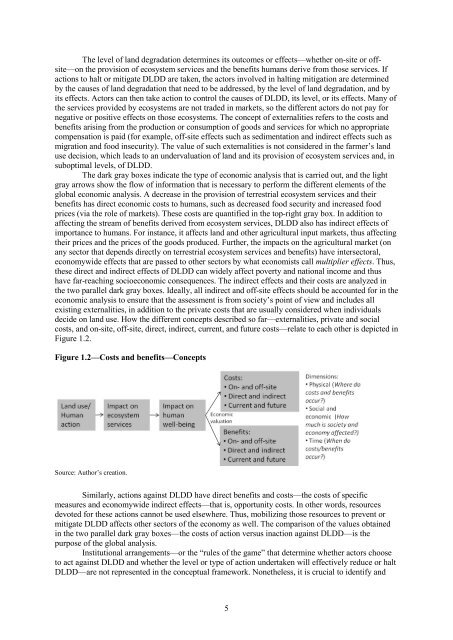The Economics of Desertification, Land Degradation, and Drought
The Economics of Desertification, Land Degradation, and Drought
The Economics of Desertification, Land Degradation, and Drought
Create successful ePaper yourself
Turn your PDF publications into a flip-book with our unique Google optimized e-Paper software.
<strong>The</strong> level <strong>of</strong> l<strong>and</strong> degradation determines its outcomes or effects—whether on-site or <strong>of</strong>fsite—on<br />
the provision <strong>of</strong> ecosystem services <strong>and</strong> the benefits humans derive from those services. If<br />
actions to halt or mitigate DLDD are taken, the actors involved in halting mitigation are determined<br />
by the causes <strong>of</strong> l<strong>and</strong> degradation that need to be addressed, by the level <strong>of</strong> l<strong>and</strong> degradation, <strong>and</strong> by<br />
its effects. Actors can then take action to control the causes <strong>of</strong> DLDD, its level, or its effects. Many <strong>of</strong><br />
the services provided by ecosystems are not traded in markets, so the different actors do not pay for<br />
negative or positive effects on those ecosystems. <strong>The</strong> concept <strong>of</strong> externalities refers to the costs <strong>and</strong><br />
benefits arising from the production or consumption <strong>of</strong> goods <strong>and</strong> services for which no appropriate<br />
compensation is paid (for example, <strong>of</strong>f-site effects such as sedimentation <strong>and</strong> indirect effects such as<br />
migration <strong>and</strong> food insecurity). <strong>The</strong> value <strong>of</strong> such externalities is not considered in the farmer’s l<strong>and</strong><br />
use decision, which leads to an undervaluation <strong>of</strong> l<strong>and</strong> <strong>and</strong> its provision <strong>of</strong> ecosystem services <strong>and</strong>, in<br />
suboptimal levels, <strong>of</strong> DLDD.<br />
<strong>The</strong> dark gray boxes indicate the type <strong>of</strong> economic analysis that is carried out, <strong>and</strong> the light<br />
gray arrows show the flow <strong>of</strong> information that is necessary to perform the different elements <strong>of</strong> the<br />
global economic analysis. A decrease in the provision <strong>of</strong> terrestrial ecosystem services <strong>and</strong> their<br />
benefits has direct economic costs to humans, such as decreased food security <strong>and</strong> increased food<br />
prices (via the role <strong>of</strong> markets). <strong>The</strong>se costs are quantified in the top-right gray box. In addition to<br />
affecting the stream <strong>of</strong> benefits derived from ecosystem services, DLDD also has indirect effects <strong>of</strong><br />
importance to humans. For instance, it affects l<strong>and</strong> <strong>and</strong> other agricultural input markets, thus affecting<br />
their prices <strong>and</strong> the prices <strong>of</strong> the goods produced. Further, the impacts on the agricultural market (on<br />
any sector that depends directly on terrestrial ecosystem services <strong>and</strong> benefits) have intersectoral,<br />
economywide effects that are passed to other sectors by what economists call multiplier effects. Thus,<br />
these direct <strong>and</strong> indirect effects <strong>of</strong> DLDD can widely affect poverty <strong>and</strong> national income <strong>and</strong> thus<br />
have far-reaching socioeconomic consequences. <strong>The</strong> indirect effects <strong>and</strong> their costs are analyzed in<br />
the two parallel dark gray boxes. Ideally, all indirect <strong>and</strong> <strong>of</strong>f-site effects should be accounted for in the<br />
economic analysis to ensure that the assessment is from society’s point <strong>of</strong> view <strong>and</strong> includes all<br />
existing externalities, in addition to the private costs that are usually considered when individuals<br />
decide on l<strong>and</strong> use. How the different concepts described so far—externalities, private <strong>and</strong> social<br />
costs, <strong>and</strong> on-site, <strong>of</strong>f-site, direct, indirect, current, <strong>and</strong> future costs—relate to each other is depicted in<br />
Figure 1.2.<br />
Figure 1.2—Costs <strong>and</strong> benefits—Concepts<br />
Source: Author’s creation.<br />
Similarly, actions against DLDD have direct benefits <strong>and</strong> costs—the costs <strong>of</strong> specific<br />
measures <strong>and</strong> economywide indirect effects—that is, opportunity costs. In other words, resources<br />
devoted for these actions cannot be used elsewhere. Thus, mobilizing those resources to prevent or<br />
mitigate DLDD affects other sectors <strong>of</strong> the economy as well. <strong>The</strong> comparison <strong>of</strong> the values obtained<br />
in the two parallel dark gray boxes—the costs <strong>of</strong> action versus inaction against DLDD—is the<br />
purpose <strong>of</strong> the global analysis.<br />
Institutional arrangements—or the “rules <strong>of</strong> the game” that determine whether actors choose<br />
to act against DLDD <strong>and</strong> whether the level or type <strong>of</strong> action undertaken will effectively reduce or halt<br />
DLDD—are not represented in the conceptual framework. Nonetheless, it is crucial to identify <strong>and</strong><br />
5

















